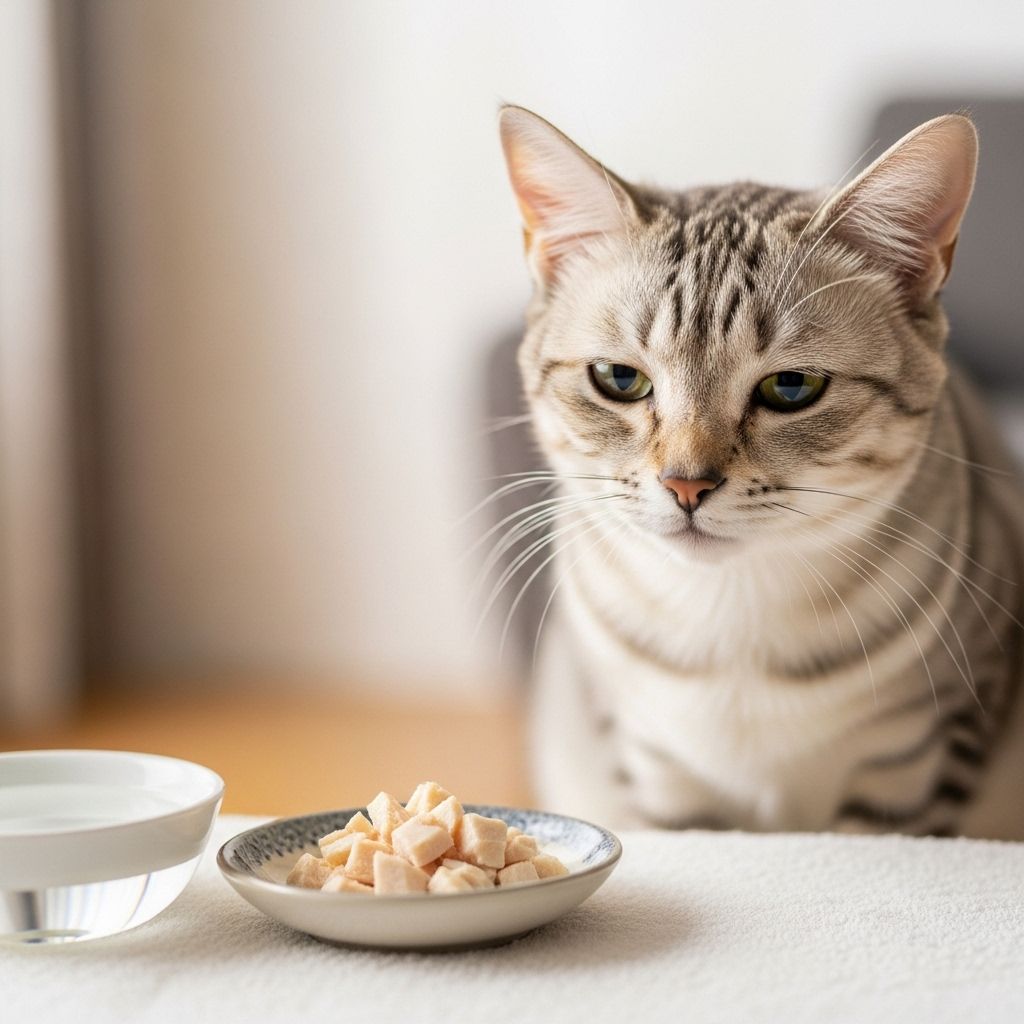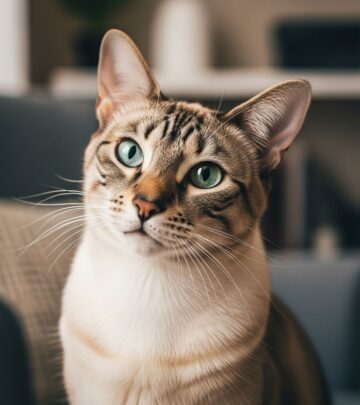What To Feed A Vomiting Cat: Complete Guide For Gentle Recovery
Discover the best feeding options and treatments for a cat experiencing vomiting episodes

Image: HearthJunction Design Team
What to Feed a Cat That is Throwing Up: A Complete Guide
Finding your beloved feline friend hunched over and vomiting can be distressing for any cat parent. While occasional vomiting might be normal for some cats (especially when dealing with hairballs), frequent or severe vomiting requires attention and appropriate care. Understanding what to feed a cat that is throwing up is crucial to help them recover and prevent further digestive upset.
This comprehensive guide will walk you through everything you need to know about caring for a vomiting cat, from identifying potential causes to implementing dietary changes that can help soothe their sensitive stomach.
Understanding Why Cats Vomit
Before determining the appropriate diet for a vomiting cat, it’s important to understand what might be causing the issue. Cats vomit for numerous reasons, ranging from minor digestive upsets to serious underlying health conditions.
Common causes of vomiting in cats include:
- Hairballs (especially in long-haired breeds or cats that groom excessively)
- Eating too quickly or overeating
- Food allergies or intolerances
- Dietary changes introduced too rapidly
- Ingestion of foreign objects or toxic substances
- Gastrointestinal infections or parasites
- Inflammatory bowel disease
- Pancreatitis
- Kidney or liver disease
- Hyperthyroidism
It’s essential to differentiate between acute vomiting (sudden onset, usually lasting less than 2-3 days) and chronic vomiting (persistent or recurring over weeks or months). While acute vomiting often resolves with simple treatment, chronic vomiting typically indicates a more serious underlying condition that requires veterinary intervention.
When to See a Veterinarian
While occasional vomiting might not be cause for immediate concern, certain signs indicate that your cat needs prompt veterinary attention. Don’t attempt to manage your cat’s diet at home if they’re showing any of these warning signs:
- Frequent or persistent vomiting (more than once per week)
- Blood in vomit (appears as red streaks or coffee-ground-like material)
- Projectile vomiting
- Vomiting accompanied by diarrhea
- Lethargy or weakness
- Decreased appetite or refusal to eat for more than 24 hours
- Signs of abdominal pain (hunching, crying when picked up)
- Dehydration (sunken eyes, dry gums, decreased skin elasticity)
- Weight loss
- Yellowing of the eyes or gums (jaundice)
Remember that cats can become seriously dehydrated quickly, especially senior cats, kittens, or those with underlying health conditions. When in doubt, it’s always better to consult with your veterinarian rather than waiting to see if the problem resolves on its own.
Immediate Care for a Vomiting Cat
If your cat has just vomited but otherwise appears normal, here are some immediate steps you can take:
- Remove food for 12-24 hours: Give your cat’s digestive system a chance to rest and recover. Always continue to provide fresh water to prevent dehydration.
- Monitor hydration: Ensure your cat is drinking water. If they’re reluctant to drink, try offering a pet water fountain or adding a small amount of tuna juice (from tuna packed in water, not oil) to encourage fluid intake.
- Watch for additional symptoms: Keep an eye out for any signs that would warrant immediate veterinary care.
- Reintroduce food slowly: After the fasting period, offer small amounts of bland, easily digestible food (more on this below).
What to Feed a Cat That is Throwing Up
Once you’ve determined that your cat’s condition doesn’t require immediate veterinary care, or your vet has provided guidance for at-home management, the next step is to choose the right foods to help your cat recover.
Bland Diet Options
A bland diet is often recommended for cats recovering from digestive upset. These options are gentle on the stomach and easy to digest:
- Boiled chicken: Plain, boneless, skinless chicken breast boiled in water (no seasonings, onions, or garlic) and shredded into small pieces.
- Plain white rice: Mixed with the boiled chicken in a ratio of approximately 50/50.
- Meat-based baby food: Choose varieties that contain only meat (chicken or turkey) with no additives, onion powder, or garlic powder.
- Prescription gastrointestinal diets: Veterinary-formulated foods like Royal Canin Gastrointestinal High Energy cat food or Hill’s Prescription Diet i/d are specifically designed for digestive issues.
Remember that homemade bland diets (like chicken and rice) are not nutritionally complete and should only be used for 2-3 days. If your cat needs to remain on a special diet longer than that, consult with your veterinarian about a prescription diet that meets all your cat’s nutritional needs.
Feeding Schedule and Portion Control
How you feed your cat is just as important as what you feed them:
- Start small: Begin with tiny portions (about 1-2 tablespoons) of food.
- Feed frequently: Offer 4-6 small meals throughout the day rather than 1-2 larger meals.
- Gradually increase: If your cat tolerates the small meals without vomiting, slowly increase portion sizes while reducing frequency over several days until you return to a normal feeding schedule.
- Elevate food dishes: Some cats benefit from having their food bowl slightly elevated, which can help with digestion.
- Separate multiple cats: If you have multiple cats, feed the recovering cat separately to prevent competition and fast eating.
Transitioning Back to Regular Food
Once your cat has gone 24-48 hours without vomiting on the bland diet, you can begin transitioning back to their regular food. This transition should be gradual to prevent further digestive upset:
- Day 1-2: 75% bland diet, 25% regular food
- Day 3-4: 50% bland diet, 50% regular food
- Day 5-6: 25% bland diet, 75% regular food
- Day 7: 100% regular food
If at any point during the transition your cat begins vomiting again, return to the previous step or consult your veterinarian.
Long-Term Dietary Considerations
For cats with chronic vomiting or recurring digestive issues, dietary modifications may need to be more permanent. Consider these long-term feeding strategies:
Special Diet Types
- Limited-ingredient diets: These contain fewer potential allergens, making it easier to identify and avoid problem ingredients.
- Novel protein diets: These feature protein sources your cat hasn’t been exposed to before, such as venison, duck, or rabbit.
- Hydrolyzed protein diets: The proteins in these foods are broken down into smaller components that are less likely to trigger allergic reactions.
- High-fiber diets: Can help manage hairballs and regulate gut motility.
- Grain-free options: May benefit some cats with specific grain sensitivities (though not all cats require grain-free food).
Feeding Methods to Prevent Vomiting
Sometimes, it’s not just what you feed but how you feed that makes a difference:
- Slow-feed bowls: These specially designed dishes have obstacles that force cats to eat more slowly, reducing the risk of regurgitation.
- Puzzle feeders: These interactive toys dispense small amounts of food as your cat plays, slowing down their eating and providing mental stimulation.
- Automatic portion-controlled feeders: Can dispense small meals throughout the day on a timer.
- Elevated feeding stations: May help cats with certain digestive issues by improving posture during eating.
Supplements and Remedies That May Help
In addition to dietary changes, certain supplements may help manage digestive issues in cats prone to vomiting:
- Probiotics: Help maintain healthy gut bacteria balance. Look for products specifically formulated for cats.
- Digestive enzymes: Can aid in breaking down food more effectively.
- Hairball remedies: Petroleum-based products that help hairballs pass through the digestive system.
- Slippery elm bark: A natural remedy that may soothe irritated digestive tracts (consult with your vet before using).
- Pumpkin: Small amounts of plain, canned pumpkin (not pie filling) can help regulate digestion in some cats.
Always consult with your veterinarian before adding any supplements to your cat’s regimen, as some may interact with medications or be inappropriate for certain health conditions.
Foods to Avoid
When your cat is recovering from vomiting, avoid these foods that can further irritate their digestive system:
- Rich, fatty foods (including most human foods)
- Dairy products (many cats are lactose intolerant)
- Foods with artificial colors, flavors, or preservatives
- Known allergens or ingredients that have previously caused problems
- Toxic foods like onions, garlic, chocolate, grapes/raisins
- Raw meat or fish (potential bacterial contamination)
- Highly seasoned or spicy foods
Preventing Future Episodes
Once your cat has recovered, implement these strategies to minimize the risk of future vomiting episodes:
- Regular grooming: Brush your cat frequently to reduce hairball formation, especially for long-haired breeds.
- Consistent feeding schedule: Feed at the same times each day to establish a routine.
- Gradual diet changes: When switching foods, do so over 7-10 days to allow your cat’s system to adjust.
- Stress reduction: Minimize environmental stressors, as stress can contribute to digestive issues.
- Regular veterinary check-ups: Annual exams can catch potential health issues before they become serious.
- Keep harmful substances out of reach: Prevent access to plants, chemicals, and other potential toxins.
Frequently Asked Questions (FAQs)
Q: How long should I withhold food from my vomiting cat?
A: Generally, withhold food for 12-24 hours (while always providing access to fresh water), then begin offering small amounts of bland food. However, never fast a kitten, senior cat, or cat with known health issues without veterinary guidance.
Q: Can I give my cat over-the-counter medications for vomiting?
A: No. Never give your cat human anti-nausea medications or other over-the-counter products unless specifically prescribed by your veterinarian. Many human medications are toxic to cats.
Q: My cat vomits hairballs frequently. Is this normal?
A: Occasional hairballs (typically once every week or two) can be normal, especially in long-haired cats. However, frequent hairballs may indicate an underlying issue and warrant dietary changes or veterinary consultation.
Q: Should I force-feed my cat if they refuse to eat?
A: No, force-feeding can cause stress and potentially make the situation worse. If your cat refuses food for more than 24 hours, contact your veterinarian, as this could indicate a serious problem.
Q: Can dietary changes completely resolve chronic vomiting in cats?
A: It depends on the underlying cause. For food allergies or sensitivities, appropriate dietary changes can often resolve the issue. However, vomiting due to conditions like inflammatory bowel disease or kidney disease may require medication and other treatments in addition to dietary management.
Remember that while proper nutrition plays a vital role in managing a cat’s digestive health, persistent or severe vomiting always warrants professional veterinary care. By working closely with your veterinarian and implementing appropriate dietary strategies, you can help your feline friend recover from vomiting episodes and maintain optimal digestive health for years to come.
References
- https://vcahospitals.com/know-your-pet/vomiting-in-cats
- https://bestfriends.org/pet-care-resources/cat-vomiting-types-causes-and-treatments
- https://www.vet.cornell.edu/departments-centers-and-institutes/cornell-feline-health-center/health-information/feline-health-topics/vomiting
- https://www.merckvetmanual.com/cat-owners/digestive-disorders-of-cats/vomiting-in-cats
- https://www.pdsa.org.uk/pet-help-and-advice/pet-health-hub/symptoms/vomiting-in-cats
Read full bio of medha deb












